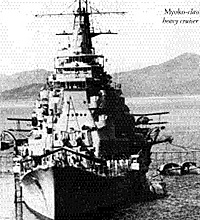 Myoko-class heavy cruiser
Myoko-class heavy cruiser
Ed Note: When the massive and definitive Japanese Cruisers of the Pacific War appeared, it was an embarrassment of riches for the CaS design team. While it was clearly written, with access to Japanese-language sources, the sheer volume of data made reviewing it for changes to the Annexes a lengthy proposition. Pressed with other design requirements, we've been forced several times to move it near the bottom of the priority list.
Luckily, James Broshot, a longtime CaS player and another seeker of the truth, has taken the time (a lot of time) to review the book, compare the statistics, and write up the results. This issue features the article he wrote to accompany the new data, and the first half of the Annex A listings, those for heavy cruisers. Light cruisers will be covered in the next issue. Several comments on the "expanded format." You will see why we can't do this with all the ship listings. Normally we can get about four to six major ships listed on a single page. In this format, it's two. Individual ship histories, including damage, refits, and loss, are listed together in the Remarks section. Because of the changes to the Lt AA armament, after the modification is described, the new Lt AA suite is listed, along with its revised strength.
Most of the Japanese ships carried reloads for their torpedoes. Based on Jim's recommendation, those reloads are now listed in the weapons section, under the appropriate line.
The publication of mammoth Japanese Cruisers of the Pacific War, by Eric Lacroix and Linton Wells II, has made available the most detailed history of the cruisers of the Imperial Japanese Navy from 1910 to the end of World War Two. Not only are design and development histories, like those in Norman Friedman's series on U. S. Navy warships provided, but operational records are collected in one volume. More importantly for Command at Sea players, the exact details on armament and sensors with subsequent modifications are found in this book. With this new source, we can update and correct specifications of the Japanese cruisers found in Command at Sea's Rising Sun: The First Half of the Pacific War. A comparison of the details in the Data Annexes with those found in Japanese Cruisers confirms most of the Command at Sea data. However, this new source allows expansion and refinement of the CaS specifications in several areas.
In Command at Sea terms the radars listed in Data Annex G1 translate as follows:
| Lacriox | CaS | Function |
|---|---|---|
| No 13 | Type 3 Mk 1 | Air Search |
| No 21 | Type 2 Mk 1 | Surface Search |
| No 22 | Mk2 Mod 2 | Surface Search |
An additional listing under Sensors has been added to show the number and type of surface (LA) fire control directors fitted. As a general rule, all heavy cruisers, like their American counterparts, were fitted with two surface fire control directors, one forward and one aft. Light cruisers, most of whom dated from World War I, had only one surface fire control director, mounted on the bridge.
Bibliography
Lacroix, Eric and Linton Wells II, Japanese Cruisers of the Pacific War; Annapolis: Naval Institute Press, 1997.
Lacroix, Eric, "The Development of 'A' Class Cruisers in the Imperial Japanese Navy, Part VI," Warship International, No. 3, 1983.
Cruisers of the Imperial Japanese Navy, Revisited Part 1
CAS Japanese Ship Stats: Aoba, Takao, Atago, Furutaka, Tone, Chikuma, Chokai, Mogami, Mikuma, Suzuya, Kumano, and Myoko
Illustrations: Cruisers Aoba, Takao, Mogami, Tone
Japanese Cruisers Part 2: Light Cruisers (NS#18)
BT
Back to The Naval Sitrep #17 Table of Contents
Back to Naval Sitrep List of Issues
Back to MagWeb Master Magazine List
© Copyright 1999 by Larry Bond and Clash of Arms.
This article appears in MagWeb (Magazine Web) on the Internet World Wide Web.
Other military history articles and gaming articles are available at http://www.magweb.com